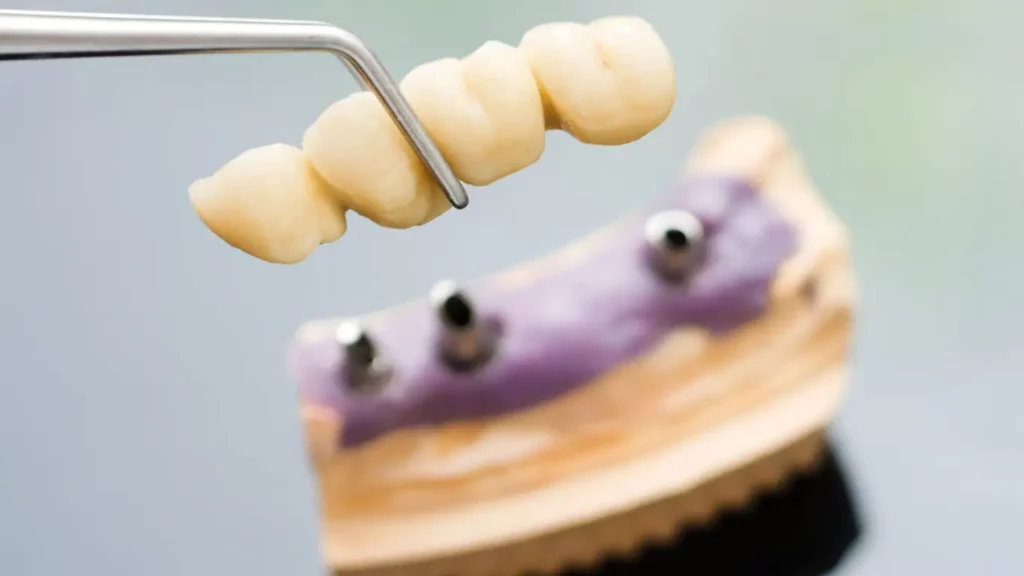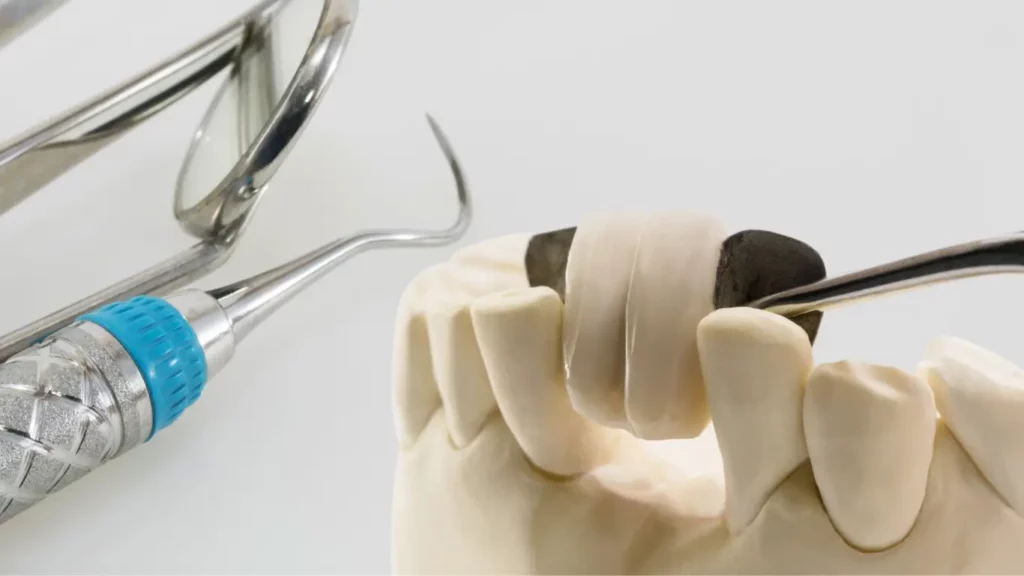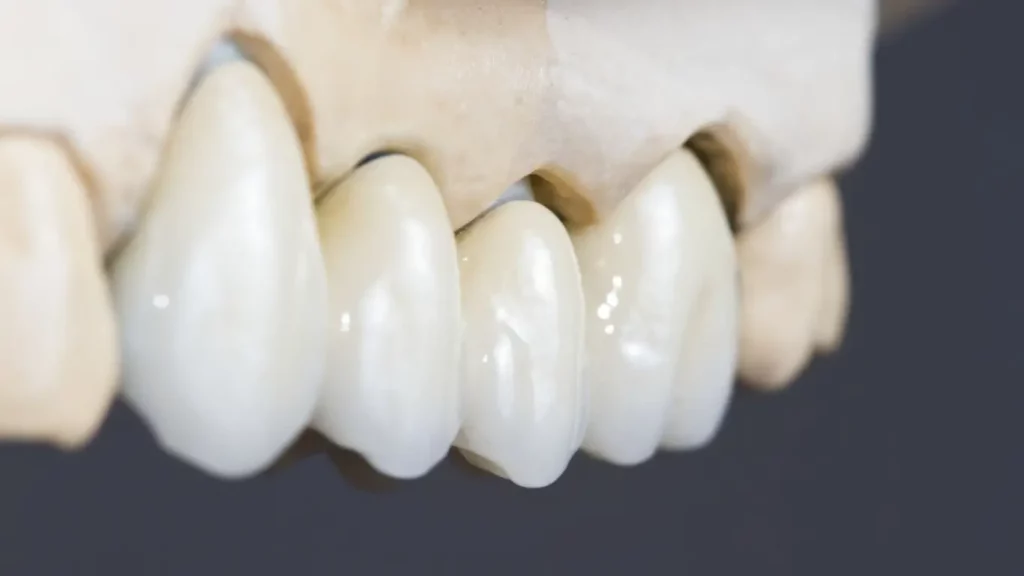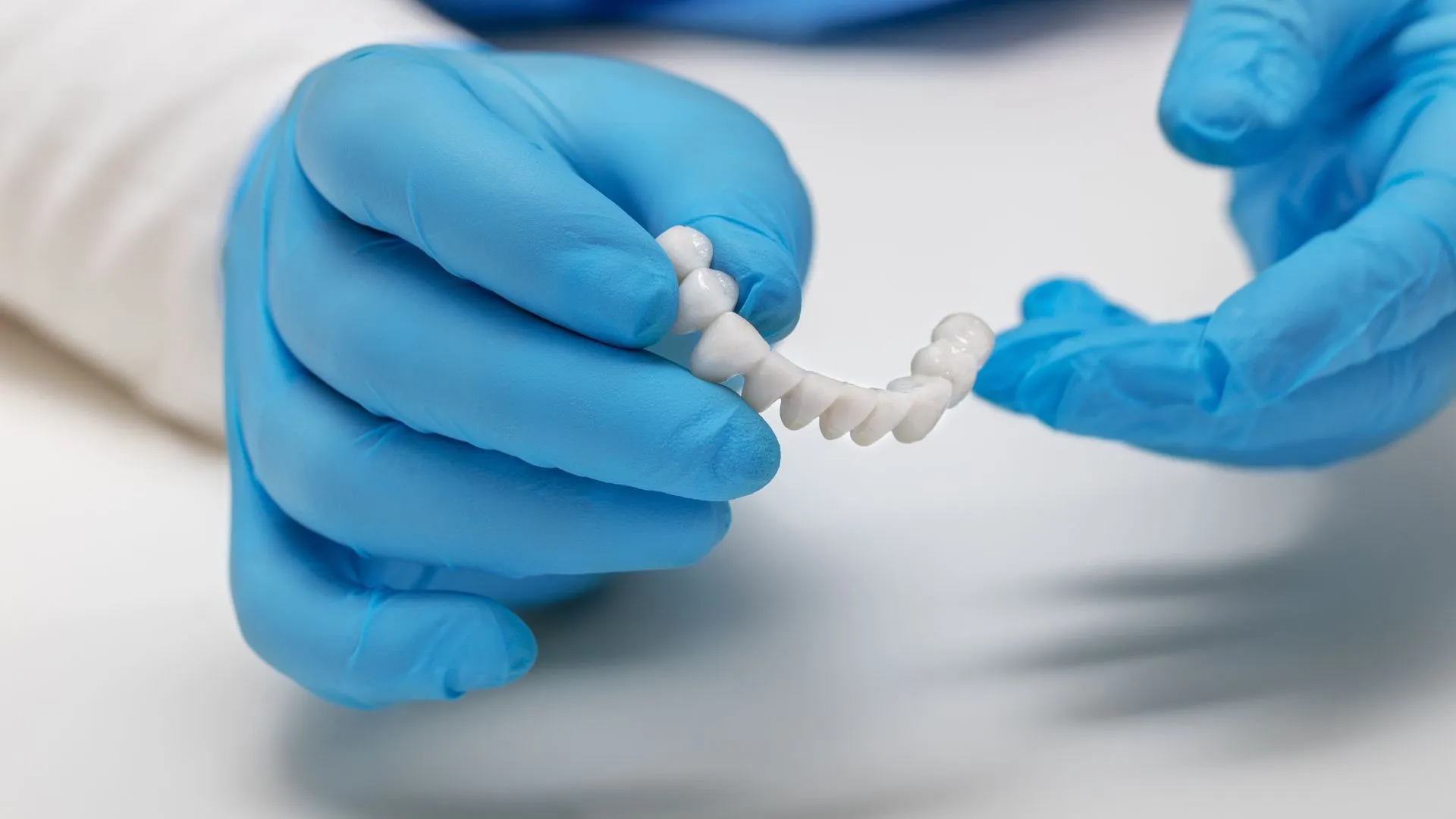A dental bridge is a custom-made replacement for one or more missing teeth that literally “bridges” the gap. When you lose a tooth, it’s not just your smile that’s affected but also your ability to enjoy everyday pleasures like eating and speaking clearly. Getting to grips with the options available for tooth replacement, like dental bridges, can significantly enhance your life quality.
This article will walk you through the ins and outs of dental bridges, including the different types available, how they’re fitted, their benefits and potential downsides, and how to look after them. We’ll also compare dental bridges with other tooth replacement solutions, equipping you with the knowledge to choose what’s best for your oral health.
Losing a tooth can be a stressful experience, affecting not just your oral health but also your confidence and daily life. It’s natural to look for solutions that offer a blend of aesthetic appeal, functionality, and durability.
That’s where dental bridges come in as a popular and effective solution.
With the right information and guidance, you can regain your smile and the confidence that comes with it.
Key Takeaways
- Dental bridges fill the gap left by missing teeth, helping you look better, eat, and speak more easily. They come in different types and are made from materials like porcelain to match your natural teeth.
- Getting a dental bridge can prevent your other teeth from moving out of place, which could cause problems with your bite and make it harder to keep your teeth clean.
- There are several types of bridges, including traditional, cantilever, Maryland, and implant-supported bridges, each with its own method of fitting and advantages. Your dentist will help you choose the best one for your needs.

Understanding Dental Bridges
Dental bridges offer a reliable solution for replacing missing teeth, blending seamlessly with your natural teeth to restore both function and aesthetics. They not only fill the gap left by missing teeth but also prevent the remaining teeth from shifting, which could lead to bite problems and other oral health issues. Here’s a deeper look into what dental bridges are, their types, and their components.
What is a Dental Bridge?
A dental bridge literally bridges the gap left by one or more missing teeth.
It consists of two main parts: the pontic, or false tooth, which replaces the missing tooth, and the abutments, which are the supporting teeth on either side of the gap. The pontic is typically made from materials like porcelain to mimic the appearance of natural teeth, offering a discreet solution for tooth loss.
Dental bridges serve a dual purpose. They restore the ability to properly chew and speak, which can often be compromised by the loss of teeth. Additionally, they improve the overall appearance of your smile, which can boost confidence and overall well-being.
Why Get a Dental Bridge?
If you’re considering ways to restore your smile due to missing teeth, a dental bridge may be the perfect solution. Not only does it offer aesthetic benefits, but it also plays a crucial role in maintaining oral health. Here’s why opting for a dental bridge can be beneficial:
- Restoring Chewing and Speaking Abilities: Missing teeth can significantly impact your ability to chew food properly and speak clearly. A dental bridge, by replacing these gaps, helps in restoring the functionality of your mouth. This means you’ll be able to enjoy your favorite foods again without difficulty and communicate more effectively.
- Aesthetic Improvement: The gap left by missing teeth can affect one’s self-esteem due to cosmetic concerns. A dental bridge not only fills this gap but is designed to blend seamlessly with your natural teeth, enhancing the overall appearance of your smile.
- Preventing Teeth from Shifting: Dental bridges maintain alignment. When there are gaps in your mouth, adjacent teeth gradually shift towards them over time. This movement can lead to misalignment issues that might require orthodontic treatment later on. By preventing shifting, bridges help maintain better oral hygiene since straighter teeth are easier to clean than those that are crowded or misaligned.

Types of Dental Bridges Explored
When it comes to bridging the gap left by missing teeth, not all solutions are created equal. The type of dental bridge that’s right for you depends on various factors, including the number and location of your missing teeth and the health of your neighboring teeth.
- Traditional Dental Bridge: This is the most common type where false teeth are held in place by dental crowns cemented onto each abutment tooth. It’s a go-to solution when you have natural teeth on both sides of the gap.
- Cantilever Dental Bridge: Similar to traditional bridges but used when there’s only one adjacent healthy tooth available. Here, only one side serves as an anchor which makes cantilever bridges a unique fix for certain situations.
- Maryland Dental Bridge: Also known as a resin-bonded bridge or Maryland bonded bridge, it involves artificial teeth attached to metal wings on either side which then bond with existing natural abutment teeth using dental cement. It’s less invasive than other types since it doesn’t require filing down adjacent healthy ones.
- Implant-Supported Bridge: Stands out because it doesn’t rely on surrounding teeth at all. Instead, it uses dental implants as its foundation – ideal if you’re looking for something sturdy and durable but requires enough bone density to support these implants.
Your dentist can help determine which option best suits your oral health needs and aesthetic goals after considering several factors like how many teeth are missing and whether neighboring teeth need restoration work too.
The Dental Bridge Procedure: What to Expect
When you’re considering a dental bridge as a solution for missing teeth, understanding the procedure can ease any apprehensions. Here’s what you should expect during the dental bridge process.
Initial Consultation and Treatment Planning
It begins with an initial consultation where your dentist evaluates your oral health and discusses whether a dental bridge is suitable for you. This visit may include X-rays or impressions of your mouth to help design a precise treatment plan tailored just for you.
Tooth Preparation
For traditional bridges, tooth preparation involves reshaping the anchoring teeth (abutments) so that crowns can be placed over them effectively. This step ensures that the bridge will fit comfortably and look natural alongside existing teeth. Local anesthesia is typically administered during this stage for comfort.
Fitting Your Temporary Bridge
Once the abutment teeth are prepared, an impression of them along with adjacent teeth is taken which serves as a model from which the lab will create both your temporary and permanent bridges. Learn more about temporary bridges here.
A temporary bridge will be fitted in place to protect exposed gums and teeth while waiting for the fabrication of your permanent fixture.
The Final Bridge Placement
This exciting phase happens once our laboratory has crafted your custom-made bridge – usually two weeks after tooth preparation. During this appointment, we’ll remove the temporary device and then check if there’s any need for adjustments before permanently bonding it into place using strong adhesives ensuring its stability within one’s bite alignment.

Advantages and Disadvantages of Dental Bridges
Dental bridges are a popular solution for replacing missing teeth, offering both aesthetic and functional benefits. However, like any dental procedure, they come with their own set of considerations. Let’s delve into the advantages and disadvantages to help you make an informed decision.
Benefits of Choosing a Dental Bridge
Aesthetics: One of the most immediate benefits is the restoration of your smile. A dental bridge fills in gaps caused by missing teeth with natural-looking prosthetics, enhancing your appearance and confidence.
- Functionality: Missing teeth can impair your ability to speak clearly or chew properly. By installing a bridge, these functions are restored, allowing for normal speech and eating habits.
- Oral Health Improvement: Gaps left by missing teeth can cause remaining teeth to shift out of place, leading to bite issues or even gum disease. A bridge helps maintain alignment by preventing such movement.
Potential Drawbacks or Considerations
- Maintenance Needs: While not excessively burdensome, bridges do require good oral hygiene practices including regular brushing and flossing around the appliance to prevent decay in anchoring teeth.
- Longevity: Dental bridges typically last 5 to 15 years before needing replacement due to wear and tear; however, this lifespan can be extended with proper care.
- Risks Involved: The procedure for fitting a bridge involves preparing the adjacent teeth that will serve as anchors (abutments), which might include removing some enamel. This process could potentially increase sensitivity or necessitate future procedures on those teeth.
Bridges offer a viable option for many people looking to restore their smiles after tooth loss, but understanding both the positive aspects and potential drawbacks is crucial for making an informed choice.
Is a Dental Bridge Right for Me?
If you’re exploring options to replace missing teeth, you might be considering a dental bridge. A dental bridge is an effective solution that can restore your smile, chewing ability, and speech clarity. But how do you know if it’s the right choice for you? Let’s delve into what makes someone a good candidate for this procedure.
Who Is a Good Candidate?
A dental bridge relies on neighboring teeth or implants to support the replacement tooth (or teeth). Therefore, candidates with healthy adjacent teeth and sufficient bone structure are ideal. If these supporting teeth are strong and free of severe decay or gum disease, they can effectively anchor the bridge.
- Adequate Bone Support: Sufficient jawbone density is crucial to support either natural tooth anchors or dental implants used in conjunction with bridges.
- Healthy Neighboring Teeth: The success of a bridge significantly depends on the health of surrounding teeth since they provide support.
Factors Your Dentist Will Consider
Your dentist will evaluate several factors before recommending a dental bridge. These include:
- The overall health of your oral cavity: Healthy gums and remaining teeth are essential for the longevity of your dental bridge.
- The location of the missing tooth (or teeth): Bridges are more successful in certain areas of the mouth than others due to varying bite forces and aesthetic considerations.
- Your aesthetic goals: Depending on where in your mouth your missing tooth is located, different materials can be used to meet both functional needs and cosmetic preferences.
Determining whether you’re an ideal candidate requires consultation with professionals who understand not only the structural requirements but also aim to achieve results that align with your personal desires.
Caring for Your Dental Bridge
Maintaining a dental bridge is crucial for both the longevity of the prosthetic and your overall oral health. With proper care, dental bridges can last many years, providing you with a functional and aesthetically pleasing smile. Here are some essential tips on how to keep your dental bridge in top condition.
Practice Good Oral Hygiene
Good oral hygiene is the cornerstone of caring for your dental bridge. It’s recommended to brush your teeth twice daily using fluoride toothpaste. When brushing, pay special attention to all surfaces of the teeth and gums, including those areas around and under the bridge. This helps remove plaque and prevent cavities from forming at the edges of the bridge.
Flossing is also paramount but requires a specific technique when you have a dental bridge. Using floss threaders can help navigate beneath the false tooth (or pontic) that sits above gum level within your bridgework, ensuring that no food particles or plaque remain trapped.
Regular Dental Visits Are Key
Scheduling regular check-ups with your dentist ensures any potential issues with your dental bridge are identified early on. During these visits, professional cleanings will remove tartar build-up inaccessible by home brushing and flossing alone—a vital step in preventing gum disease which could undermine your bridgework’s foundation.
Diet Considerations: Foods to Avoid
Incorporating softer foods into one’s diet immediately after getting a new bridgework while gradually reintroducing harder items allows time for adjustment without risking harm to it.
- Chewing ice or hard candies can damage not only natural teeth but also put undue stress on a dental bridge.
- Items like caramel or chewing gum should be avoided as they can pull at and weaken the bond between an existing tooth structure and its artificial counterpart within a bridge setup.
- Avoid overly crunchy snacks such as popcorn kernels which might get lodged causing discomfort or even damage.
Exploring Alternatives to Dental Bridges for Tooth Replacement
When it comes to replacing missing teeth, dental bridges have long been a popular choice. However, with advancements in dental technology and materials, there are now several effective alternatives available. Understanding these options can help you make an informed decision based on factors such as cost, oral health condition, and personal preference.
Dental Implants: A Durable Solution
Dental implants stand out as one of the most durable and aesthetically pleasing alternatives to dental bridges. An implant consists of a titanium post that is surgically inserted into the jawbone, acting as an artificial root. Once healed, a crown is attached to this post providing the appearance and function similar to natural teeth. The key advantages of dental implants include their longevity, strength, and ability not only to replace lost teeth but also to preserve bone structure preventing facial collapse due to bone loss.
- Pros: Natural look; prevents bone loss; no need for adjacent tooth alteration.
- Cons: Higher upfront costs; requires surgery; longer healing period.
Dentures: Cost-effective & Removable Option
If you’re looking for a more budget-friendly alternative or require multiple teeth replacement solutions at once – dentures might be your go-to option. Available in full sets or partials (for those who still have some natural healthy teeth), dentures are custom-made removable appliances designed to mimic the look of gums and teeth closely. While they do offer convenience being easily removable for cleaning purposes,
The pros include:
- Affordability
- No surgical procedures required
- Quick adjustment period.
- Dentures provide flexibility in terms of adjustments over time, adapting if your mouth changes shape due to the aging process.
The cons include:
- Entail regular maintenance requirements
- Potential discomfort during initial use
- May affect speech or eating until adjusted properly.

Cost and Insurance Coverage for Dental Bridges
If you’re considering getting a dental bridge, understanding the cost involved and how insurance may cover these expenses is crucial. The price of dental bridges can vary widely depending on several factors, including the type of bridge, materials used, complexity of the placement procedure, and geographic location. Generally speaking, dental bridges can range from $500 to $1,500 per artificial tooth. However, when factoring in the cost of additional crowns needed to support the bridge, total expenses could climb between $3,000 to $5,000.
Finding Out What Your Insurance Covers
Most dental insurance plans offer some level of coverage for dental bridges since they are considered a necessary restorative procedure rather than cosmetic. However, dental insurance policies vary greatly, so it’s essential to check with your provider about what exactly is covered under your plan. Some insurances might cover up to 50% of restorative procedures like bridges after deductibles are met.
- Contact Your Insurance Provider: Start by calling or reviewing your policy details online to understand your coverage limits and any prerequisites such as waiting periods.
- Inquire About Specifics: Ask if there’s a difference in coverage between different types of materials (e.g., porcelain vs metal) or procedures (traditional vs implant-supported bridges).
- Deductibles & Maximums: Understand how much you’re expected to pay out-of-pocket annually before insurance kicks in and know your yearly maximum benefit amount.
Talking With Your Dentist About Costs And Payment Options
Your dentist plays an important role not only in providing treatment but also in helping navigate payment options that fit within your budget. Many offices offer financing plans, sometimes even interest-free – making expensive treatments more manageable over time. Additionally, they can provide detailed estimates that break down costs which you can then compare against what’s covered by insurance – ensuring no surprises along the way. It’s advisable to always consult directly with both parties: this proactive approach helps mitigate unexpected expenditures significantly.
Frequently Asked Questions
Embarking on the journey to replace missing teeth with dental bridges raises many questions. Diving straight into the heart of your worries, we aim to address and clarify any doubts you might have, ensuring you’re well-equipped with knowledge.
Is a dental bridge painful?
Pain is often a big worry but rest easy. Most people report minimal discomfort during and after the bridge procedure. Local anesthesia ensures the process is as comfortable as possible, turning what sounds scary into something quite manageable.
Read more about it here.
Can a dental bridge be removed?
Dental bridges are designed to be long-lasting solutions for missing teeth, typically anchored firmly in place by abutment teeth or implants. However, they aren’t permanent fixtures and may need replacing every five to 15 years due to wear or oral health changes.
How long can you wait to get a dental bridge?
The sooner, the better when it comes to filling gaps left by missing teeth. Waiting too long can lead to shifting of neighboring teeth and potential bone loss—issues that complicate future treatments like bridges or implants significantly.

Your Bridge to a Brighter Smile
Dental bridges open up a pathway to restoring not just the gaps in your teeth but also bringing back the confidence in your smile. Choosing the perfect dental bridge for you isn’t just about filling spaces. It’s about enhancing your life and making meals more enjoyable, and conversations easier. The care for your dental bridge mirrors the simple steps you take to keep your natural teeth healthy, blending seamlessly into your daily routine.
As you weigh your options for a complete smile, think of a dental bridge as more than a procedure—it’s a step toward a future filled with laughter, confidence, and the joy of life’s everyday moments. With a commitment to regular dental care, your bridge will not only look great but also stand the test of time, showcasing the strength and beauty of modern dental solutions.
Ready to Bridge the Gap in Your Smile?
If you’re looking to restore the beauty and functionality of your smile with a dental bridge, Soundview Family Dental is here to guide you every step of the way. From choosing the right type of bridge to ensuring it fits perfectly with your lifestyle, our team is dedicated to helping you achieve a smile that lights up the room. Don’t let missing teeth hold you back any longer. Take the first step towards a future filled with confidence and joy in every smile.
Contact us today at (425) 563-6360 to schedule your consultation and discover how we can help you bridge the gap towards a brighter, more confident you.


